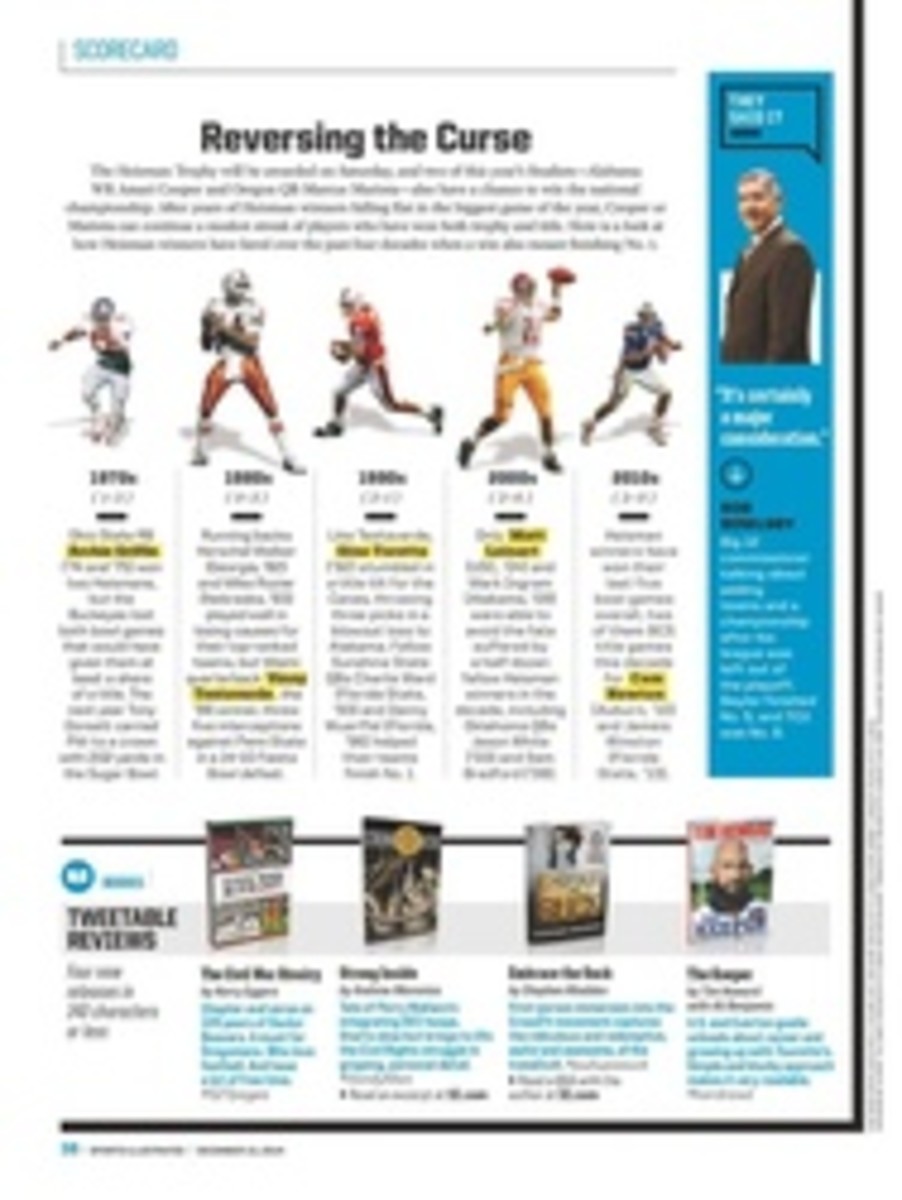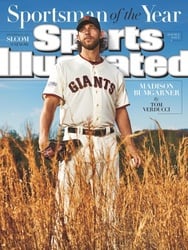
Cold Comfort
WHEN HIS then 27-year-old son was diagnosed with amyotrophic lateral sclerosis in 2012, John Frates made it his family's crusade to lobby the Federal Drug Administration and CEOs of drug companies for funding and research. National awareness of ALS began with Lou Gehrig's famous "luckiest man" speech in 1939, but there was still no cure for the vicious neurological disease or even any known causes. Frates wanted to know why his son Pete, a former captain of the Boston College baseball team, would soon be robbed of his ability to talk, walk and swallow food.
The elder Frates confronted a sobering truth: The fight against ALS lacked urgency. Every meeting he attended, every impassioned presentation he gave and every rubber-chicken banquet he sat through yielded increasing frustration. Audiences shed tears and sometimes wrote checks, but sustaining momentum was a constant struggle. So Frates, a city councilman and semiretired investment sales manager in Beverly, Mass., brainstormed ways to better help his son and the estimated 30,000 other Americans who suffer from ALS. With Gehrig's speech in mind, Frates pinned his hopes on sports. "A few people scoffed," he says. "Like yeah, sure, having an athlete speak out is going to make a difference."
The naysayers were partially right. No one athlete could transform ALS into a cause cél√®bre. Neither could the gut-wrenching stories of O.J. Brigance, Steve Gleason and Orlando Thomas, retired NFL players afflicted with ALS. But those who doubted Frates's plan underestimated the collective reach of the sports community in the digital age. On July 31, Pete posted a 52-second video to Facebook extending what came to be known as the Ice Bucket Challenge. The mechanics are simple: Dump a bucket of ice over your head, post it to social media, then nominate others to either do the same within 24 hours or make a donation. In practice, most of those who accepted the challenge donated as well, until it became a surging wave of giving.
Pete didn't invent the idea for the Ice Bucket Challenge—it was passed along from Pat Quinn, 31, an ALS patient from New York who got it from Anthony and Jeanette Senerchia, who were tagged by Jeanette's cousin's husband, Chris Kennedy, a professional golfer from Sarasota, Fla. In fact, at that point the challenge was extended without a specific charity in mind. But by the time it reached Frates, the connection between ALS and the IBC was solidifying; his network then took the idea into the mainstream.
As hundreds of Pete's friends and family took part, it reached Patriots wide receiver Julian Edelman (whom Frates had tagged on Facebook) and several members of the Bruins. Soon after, Derek Jeter and Michael Jordan filmed videos. Before long, college football teams were getting sprayed by hoses, and LeBron James was being doused on a yacht. Roger Goodell upended a garbage can full of ice water onto his head in a driveway; Paul Bissonnette, an NHL leftwinger, had a helicopter dump glacier water on him as he stood wearing only skates and a Speedo on a mountaintop overlooking Widgeon Lake in British Columbia. Even Bill Belichick found reason to shed his beloved hoodie. And then came the nonsports celebrities: George W. Bush, Taylor Swift, Steven Spielberg. Justin Bieber did it twice (once with a shirt, once without). The momentum, finally, seemed unstoppable.
"Our story, the realities of ALS and the journey the patient goes on, have now been recognized as unacceptable," says Pete, who is only able to communicate by looking at an on-screen keyboard that tracks the movement of his eyeballs. "To the whole world."
THE ALS ASSOCIATION reported more than $100 million in donations from July 29 to Aug. 29, a staggering uptick over the $2.8 million during the same time span in the previous year. In 2013 the ALSA national office received $128,000 in online donations; so far in '14 it has reaped $96 million. "To raise this much money in such a short time is absolutely astounding," says ALSA spokesperson Brian Frederick. This fall the association announced it would triple the amount of money it has spent on research, including an initial $21.7 million to launch six initiatives hoping to expedite a treatment. Four of the programs are collaborative research studies identified as critical for discovering new therapies. "We now have tremendous momentum in the search for a cure," says ALSA CEO Barbara Newhouse.
Because the Ice Bucket Challenge was simple and fun, some critics tagged it as "slacktivism." As countless people shared videos of themselves showing off their summer bodies and shrieking at the bone-chilling water, it was easy to wonder if they knew exactly why they were participating. For decades, ALS advocates had difficulty raising research money because the rare disease is complex to explain—and because the outlook is so bleak. There are no survivors. When patients are diagnosed, they're told they most likely have two to five years left to live. And they're not good years.
In Nashville, Tim Shaw was coming to terms with that reality. A 30-year-old former special teams captain for the Titans, he had been coping in private with the ALS diagnosis he had received in March. Inspired by the movement, he shared his story by posting a video on the team's website on Aug. 19. "At that point," he says, "I could no longer hide. I wanted to join the public fight."
Already, Shaw had gone from hard-hitting linebacker to someone who could no longer execute a 15-pound biceps curl. When he was diagnosed, he was still able to run six miles a day. By October, his speech was slightly slurred and walking had become a challenge. The next months will only get harder. He will spend hours in a studio recording his voice so that when he is no longer able to speak, people will still be able to hear him through a computer that he'll control with his eyes. His parents sold their home in Livonia, Mich., and moved to Nashville to become his caregivers. "A lot of people have asked if football had any role in my contracting the disease," Shaw says. "I don't have the answer to that."
A SIGNIFICANT NUMBER of ALS patients are former athletes, and researchers are looking at possible links to the disease and head trauma. A 2012 research study sponsored by the Centers for Disease Control and Prevention found that NFL players were three times as likely as the general population to die of diseases that damage brain cells, such as Alzheimer's, Parkinson's and ALS. "If those studies end up being confirmed as true," says Steve Gleason, "I think I was unknowingly at higher risk."
A former special teams ace himself for the Saints, Gleason became a folk hero when he blocked a punt in New Orleans's first home game after Hurricane Katrina. Since being diagnosed with ALS in 2011, he's only doubled down on his mantra: "No white flags." He's skydived; he's trekked up Machu Picchu with the help of friends; he's spoken one-on-one with Bill Gates about combating his disease. He has also privately gathered funds and partnered with neuroscientists, researchers, academics and pharmaceutical companies to help develop one of the most ambitious initiatives in the history of ALS research.
Gleason's goal is one that many in the medical community view as realistic: impeding the progress of ALS. Currently the only FDA-approved drug on the market is Riluzole. "It slows the disease, but ever so slightly that you don't even notice it," says neuroscientist Jeffrey Rothstein, director of the Brain Science Institute and the Robert Packard Center for ALS at Johns Hopkins, who has worked closely with Gleason. "So we are looking for a far better drug."
Dumping Gatorade on victorious coaches has been a tradition in sports since the 1980s, but the Ice Bucket Challenge doesn't appear to be as durable. Summer faded into autumn, and the videos and conversation dwindled. The early-November death of Orlando Thomas, the 42-year-old former Vikings safety afflicted with ALS, was yet another loss for a community still fighting for even partial answers. Thomas lived for 10 years after his diagnosis; friends say he fought with dignity, even through his final few months, when he weighed 70 pounds. "All that matters is, Did you have purpose in your life, and did you impact people?" Gleason says. "Orlando did those two things."
Gleason's eloquence only exacerbates the cruelty of ALS, which atrophies the body but leaves the mind untouched. In his dreams, he sees himself as he used to be. "Yelling, laughing, running, playing," he says, only to be doused by a splash of cold reality every morning. "So I suppose the nightmare begins when I wake up."
Although the success of the Ice Bucket Challenge will not alter the bleak reality facing Gleason or Frates, that won't stop them or their supporters from continuing the fight against ALS. On Dec. 27, the Frateses will host another frigid fund-raiser near their home, at Good Harbor Beach: their third annual Plunge 4 Pete polar bear swim.
Since learning he has ALS, Gleason has doubled down on his mantra: "No white flags."
PHOTO
EVAN PIKE/CAL SPORT MEDIA (NORTH CAROLINA BASKETBALL)
PHOTO
MARK HUMPHREY/AP (TITANS)
PHOTO
MATT CASHORE/USA TODAY SPORTS (RICE MASCOT SAMMY THE OWL)
PHOTO
JOSE CARLOS FAJARDO/MCT/ZUMAPRESS.COM (INDYCAR DRIVER RYAN HUNTER-REAY)
PHOTO
NATHANIEL S. BUTLER/NBAE/GETTY IMAGES (USA BASKETBALL MEN'S TEAM)
PHOTO
JARED C. TILTON/GETTY IMAGES (NASCAR DRIVER BRIAN VICKERS)
PHOTO
ROSS KINNAIRD/GETTY IMAGES (GOLFERS JUSTIN ROSE, LEFT, AND BRANDT SNEDEKER)
PHOTO
ITALY PHOTO PRESS/ZUMAPRESS.COM (ITALY SOCCER TEAM COACH ANTONIO CONTE)
PHOTO
DAVID COOPER/TORONTO STAR/GETTY IMAGES (MAPLE LEAFS COACH RANDY CARLYLE)
PHOTO
MICHAEL HICKEY/GETTY IMAGES (KISS)
PHOTO
ALEXANDER HASSENSTEIN/BONGARTS/GETTY IMAGES (BAYERN MUNICH MASCOT BERNIE)
PHOTO
MATTHEW J. LEE/THE BOSTON GLOBE/GETTY IMAGES
BOSTON PROUD Frates, a former BC outfielder (above, in 2006) diagnosed with ALS in '12, was drenched on camera at Fenway Park on Aug. 15.
PHOTO
DAMIAN STROHMEYER FOR SPORTS ILLUSTRATED
[See caption above]
PHOTO
BOB ROSATO/SPORTS ILLUSTRATED
HARD QUESTIONS Gleason, the Saints' former special-teamer, says he doesn't know if football contributed to his ALS.
PHOTO
BILL HABER/AP
[See caption above]

